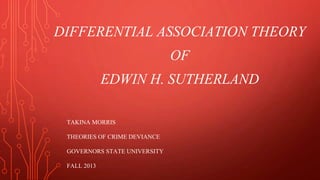
Differential Association Theory- Takina Morris
- 1. DIFFERENTIAL ASSOCIATION THEORY OF EDWIN H. SUTHERLAND TAKINA MORRIS THEORIES OF CRIME DEVIANCE GOVERNORS STATE UNIVERSITY FALL 2013
- 2. • Edwin H. Sutherland was born on August 13, 1883 in Gibbon, Nebraska. • In 1906, Sutherland left his hometown to study at the University of Chicago. • Sutherland received his doctorate in 1913 and later joined the sociology department at Indiana University. • Sutherland held this post until his death in 1950.
- 3. • Edwin Sutherland was influenced by the Chicago School’s Criminological Theories and developed the Differential Association Theory. • The Chicago School theories’ focal point was that crime stemmed from an individual’s social and physical environment and did not include pathological factors.
- 4. • Sutherland based his theory on the works CliffordR. Shaw of Shaw and McKay’s observation that generations handed down delinquent values to the next generation. • Differential Association Theory is a socialpsychological theory that states criminal behavior was a learning process and was learned through social interactions. Henry D. McKay
- 5. • Sutherland described this learning process as differential association and noted that there is a culture conflict, especially in inner city environments. • There are two cultures, criminal and conventional, and they competed for the loyalty of the residents. • The key that determined which culture an individual would be more interested in was the culture that the individual felt more connected with, i.e. thieves have more in common with thieves; drug addicts have more in common with drug addicts; athletes have more in common with athletes. • Sutherland contended that these encounters were inevitable and the individual would either be more favorable to violation or non-violation of law. • There are only two choices and the more influential choice would determine which way an individual would embrace.
- 6. Nine Propositions On The Causes Of Crime Sutherland composed nine propositions that he deemed as causes of crime: (1) Criminal behavior is learned. (2) Criminal behavior is learned in interaction with other persons in a process of communication. (3) The principal part of the learning of criminal behavior occurs within intimate personal groups. (4) When criminal behavior is learned, the learning includes: (a) techniques of committing the crime, which sometimes are very complicated, sometimes are very simple; and (b) the specific direction of motives, drives, rationalizations, and attitudes. (5) The specific direction of motives and drives is learned from definition if legal codes as favorable and unfavorable.
- 7. Nine Propositions Cont’d. (6) A person becomes delinquent because of an excess of definitions favorable to violation of law over definitions unfavorable to violation of law. This is the principle of differential association. (7) Differential associations may vary in frequency, duration, priority, and intensity. (8) The process of learning criminal behavior by association with criminal and anti-criminal patterns involves all mechanisms that are involved in any other learning. (9) While criminal behavior is an expression of general needs and values, it is not explained by those general needs and values since noncriminal behavior is an expression of the same needs and values (Sutherland & Cressy, 1970, pp. 75-76; Lilly, Cullen & Ball, 2011, pp. 48-49)
- 8. • In support of this theory, Sutherland wrote a documentary about a professional thief named “Chic Conwell” titled The Professional Thief. • This study confirmed that association with certain groups of people determined which group an individual would become associated with; in this instance an average individual associating with a group of professional thieves and becoming a professional thief.
- 9. Sutherland also proclaimed that differential association did not only apply to the lower class but it also applied to respectable individuals with high social status. He termed this as “white- collar crime.” Lawlessness could be found at corporations, politics, and among professionals. Bernard Madoff Charles Ponzi Jack Abramoff Jesse Jackson Jr. and Sandi Jackson
- 10. • Sutherland developed a theory that crime was not determined by a particular class of people but that criminal behavior was learned through social interactions. • The more an individual was exposed to deviant behavior and interacted with groups who deemed deviant behavior as a way of life, the more they would partake in such deviant behavior. This association allowed an individual to become more efficient in committing crime. • The more an individual was exposed to positive behavior and socialized with individuals who valued lawful behavior, the more they would partake in such positive behavior.
- 11. REFERENCES Sutherland & Cressy, 1970, pp. 75-76; Lilly, Cullen & Ball, 2011, pp. 48-49 Lilly, Cullen & Ball, 2011 Jacoby, 1994, pp. 24-25; http://criminology.fsu.edu/crimtheory/sutherland.html, para. 42